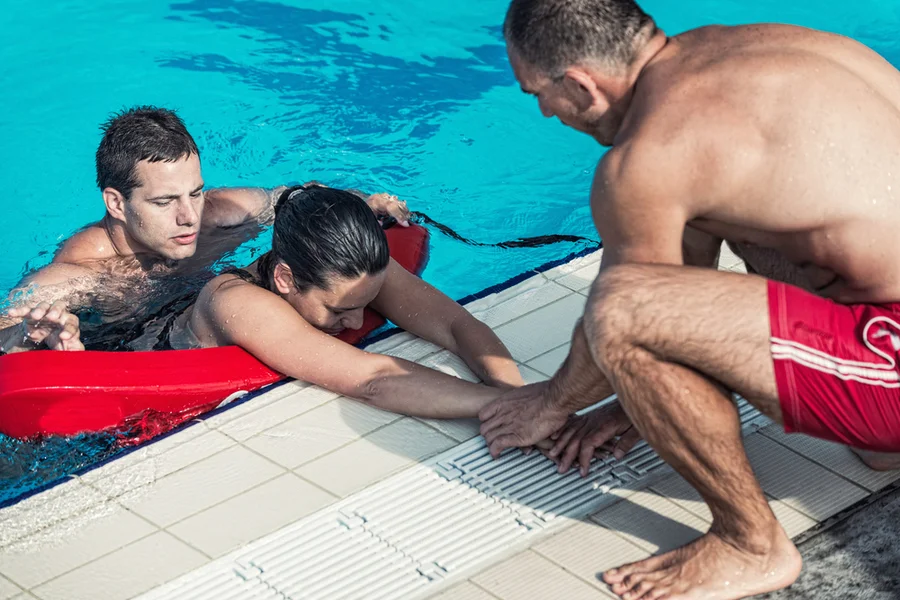Lifeguarding is more than just watching over swimmers — it’s a responsibility that demands sharp awareness, quick decision-making, physical fitness, and a deep understanding of water safety. Whether you’re supervising a pool, beach, or waterpark, the role of a lifeguard is critical in preventing accidents and saving lives.
To become a truly effective lifeguard, you must master a combination of technical and interpersonal skills. Below are the essential skills every lifeguard should develop and continuously refine.
1. Strong Surveillance and Vigilance Skills
Lifeguards are trained to be proactive, not reactive. That means spotting potential dangers before they become emergencies.
- Why it matters: Drowning can happen silently and in seconds.
- What to focus on: Practice the 10/20 rule—scan your area within 10 seconds and reach a victim in 20.
- Improve by: Avoiding distractions, staying alert, and regularly changing your scanning patterns.
2. Effective Communication
Clear communication is vital both with the public and among lifeguard teams.
- Why it matters: Misunderstandings can delay response time or escalate conflicts.
- What to focus on: Use whistles, hand signals, and direct verbal instructions confidently and clearly.
- Improve by: Practicing communication drills and learning assertiveness techniques.
3. Physical Fitness and Endurance
A lifeguard training must be physically capable of responding quickly and powerfully to emergencies.
- Why it matters: Rescues often require swimming against currents, lifting victims, or prolonged endurance.
- What to focus on: Strength, cardiovascular endurance, and swimming proficiency.
- Improve by: Regular workouts, swim practice, and rescue drills.
4. First Aid and CPR Proficiency
Medical emergencies require immediate and skilled intervention.
- Why it matters: Fast, effective CPR or first aid can mean the difference between life and death.
- What to focus on: Proper CPR techniques, wound care, and emergency response protocols.
- Improve by: Taking refresher courses and practicing with up-to-date training equipment.
5. Risk Assessment and Prevention
A key part of lifeguarding is preventing accidents before they occur.
- Why it matters: Most emergencies are avoidable with proactive safety measures.
- What to focus on: Identifying hazards like slippery surfaces, unsafe behavior, or poor weather conditions.
- Improve by: Conducting regular safety checks and staying informed about environmental risks.
6. Rescue Techniques and Water Entry Skills
Knowing how to enter the water safely and perform different rescue types is fundamental.
- Why it matters: The wrong approach can put both lifeguard and victim in more danger.
- What to focus on: Stride jumps, compact jumps, reaching assists, and spinal injury procedures.
- Improve by: Practicing varied scenarios and mastering rescue equipment use.
7. Decision-Making Under Pressure
Lifeguards often have to make quick decisions in high-stress situations.
- Why it matters: Every second counts in an emergency.
- What to focus on: Prioritizing actions, staying calm, and evaluating situations quickly.
- Improve by: Running emergency simulations and learning stress management techniques.
8. Teamwork and Leadership
A strong lifeguard team operates like a well-oiled machine.
- Why it matters: Most rescues involve more than one lifeguard.
- What to focus on: Coordinating with others, sharing responsibilities, and supporting your team.
- Improve by: Practicing group drills and building trust with coworkers.
9. Legal and Ethical Awareness
Understanding the legal responsibilities and ethical expectations of your role protects both you and those in your care.
- Why it matters: A lack of knowledge can result in liability issues or compromised safety.
- What to focus on: Duty to act, consent, and confidentiality principles.
- Improve by: Studying local laws and ethical case studies related to lifeguarding.
10. Emotional Resilience and Professionalism
Lifeguarding can be emotionally intense, especially when dealing with life-threatening incidents.
- Why it matters: Maintaining mental strength helps you stay effective and avoid burnout.
- What to focus on: Managing stress, coping with trauma, and staying composed.
- Improve by: Seeking support when needed and engaging in mindfulness or stress-reduction practices.
11. Enforcing Safety Rules and Protocols
Lifeguards play a critical role in enforcing pool or beach rules that are designed to prevent accidents. These may include:
- No running on pool decks
- No diving in shallow water
- Mandatory supervision for children
- Restrictions on rough play or dangerous stunts
By consistently enforcing these rules, lifeguards reduce the chances of slip-and-fall accidents, head injuries, or panic-based incidents that can quickly turn into drownings.
Why It Matters: Rules are only effective if they are followed. Lifeguards act as active enforcers, reminding the public of safety protocols before risky behavior escalates.
12. Identifying Behavioral Red Flags
In addition to physical warning signs, lifeguards are trained to observe behavioral cues that could indicate a swimmer is in danger or may soon be:
- A swimmer lingering too long in deep water while appearing tired
- Hesitation or fear before entering the water
- A child frequently glancing at the lifeguard or caregiver
- Disoriented or erratic behavior possibly related to health issues or intoxication
By identifying these red flags, lifeguards can speak with the swimmer, intervene early, or keep a closer eye on them.
Why It Matters: Behavioral awareness is often the first and only sign of internal distress, such as fatigue, cramps, or fear, that could lead to an emergency.
13. Routine Safety Inspections
Before a facility or beach opens to the public, lifeguards and staff usually conduct routine safety checks that include:
- Ensuring life-saving equipment is in working order
- Checking water clarity and depth markers
- Verifying signage is visible and accurate
- Inspecting ladders, handrails, and pool grates
Why It Matters: An unsafe environment increases the risk of accidents. Proactive inspections ensure that all safety measures are in place, giving swimmers a secure space to enjoy the water.
14. Engaging in Ongoing Professional Training
Lifeguards must undergo continuous education and training to stay up to date with best practices in aquatic safety. This includes:
- Recertification in CPR and first aid
- New rescue techniques
- Updates on waterborne illnesses and health codes
- Scenario-based training for rare but high-risk incidents
Why It Matters: The aquatic environment is constantly evolving, and so are safety techniques. A lifeguard who remains up to date is more capable of preventing accidents before they occur.
15. Using Technology to Assist Prevention
Many modern aquatic facilities incorporate technology to assist lifeguards in their prevention efforts. Examples include:
- Underwater motion-detection systems
- Surveillance cameras focused on blind spots
- Digital alert systems that notify staff of emergencies
- Wearable devices for swimmers that track vital signs
Lifeguards are trained to use and interpret these tools to supplement their visual monitoring.
Why It Matters: Technology acts as a second set of eyes. It doesn’t replace lifeguards but enhances their ability to detect and respond to potential drownings before they happen.
16. Creating a Culture of Safety
Lifeguards also influence the broader culture of water safety by:
- Modeling good behavior (e.g., wearing proper gear)
- Engaging respectfully with the public
- Hosting safety demonstrations or swim lessons
- Promoting community awareness of drowning prevention
Why It Matters: A culture of safety encourages swimmers to be mindful and responsible. Lifeguards help instill this culture by consistently demonstrating and reinforcing positive habits.
17. Collaborating with Medical and Emergency Personnel
In larger aquatic environments or events, lifeguards often coordinate with emergency responders, EMTs, or medical teams. This ensures that:
- Medical care is immediately accessible if needed
- Emergency action plans are rehearsed and familiar
- Communication lines are clear during large-scale incidents
Why It Matters: Seamless collaboration ensures that even rare or severe situations are managed quickly, reducing the chance of loss of life or serious injury.
Final Thoughts
Lifeguarding is a noble and demanding profession that requires a blend of physical ability, sharp judgment, and emotional intelligence. Mastering these key skills is not a one-time achievement but an ongoing commitment to excellence, safety, and responsibility.
Whether you’re a new lifeguard or a seasoned veteran, continually refining your skills ensures you’re always ready to protect lives when it matters most.
Must Read: Ms Travaloo







